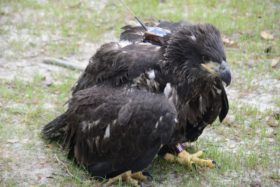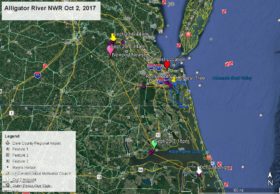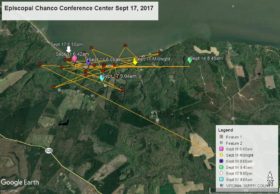How Old are The NBG Adults?
Azalea Makes Quick Visit to Norfolk
March 23, 2010Azalea Returns to Mattamuskeet – Again
March 26, 2010
The question is asked every day – How old are the NBG adults? Here is the best answer we can give based on what we know and what we assume we know. The previous nest located on the opposite side of the Norfolk airport was first identified as a bald eagle nest by CCB Research Associate Shawn Padgett in the summer of 2001. The nest was occupied during the 2002 season but no young produced. The male of this pair was struck and killed by an airplane in Dec 2002. By January the female had a new mate and they produced one eaglet during the 2003 season. The eagle nest tree was removed with proper permits. Since there were no other known nesting pair of bald eagles in the area it is assumed that this pair in December 2003 relocated to the Norfolk Botanical Garden and have nested there from the 2004 season to today. Neither of the adults are banded, so their exact age is not known for certain. The best we can do is estimate that the female is at least 15 years old (5 years minimum age to breed plus 10 years – 2001-2010). The male is estimated to be two years younger – at least 13 years old.




4 Comments
Reese, so many folks on the WVEC moderated discussion ask this question over and over and over! Isn’t there a way to provide a link in the moderator’s answer to send them directly to this section? This would increase readership of your very valuable posts…and more “education” for the public. Just a suggestion!
Hi Nancy – The moderators do a very good job of directing people to this site, and the direct link is posted right below the eagle cam picture. There is an answer. We have just not found it yet. For those who do it is a great opportunity to learn about bald eagle ecology.
I have seen the approximate max age for eagles is 25 or so. My question is, do they stay reproductively active up to the ripe old age of 25. They would be VERY experienced parents by then if they do.
This is an excellent illustration of the difference between the male and female. It also is an awesome portrait of the two. Thanks.